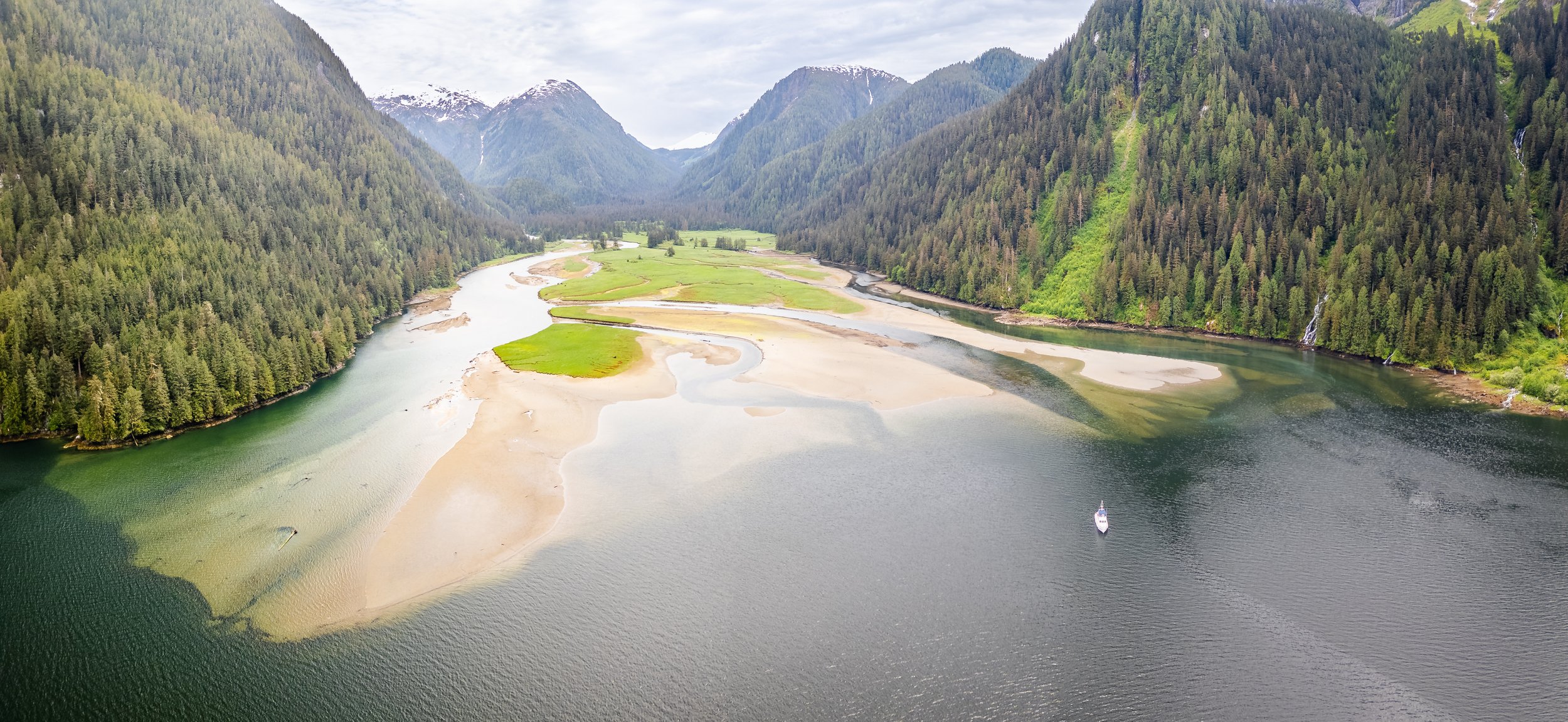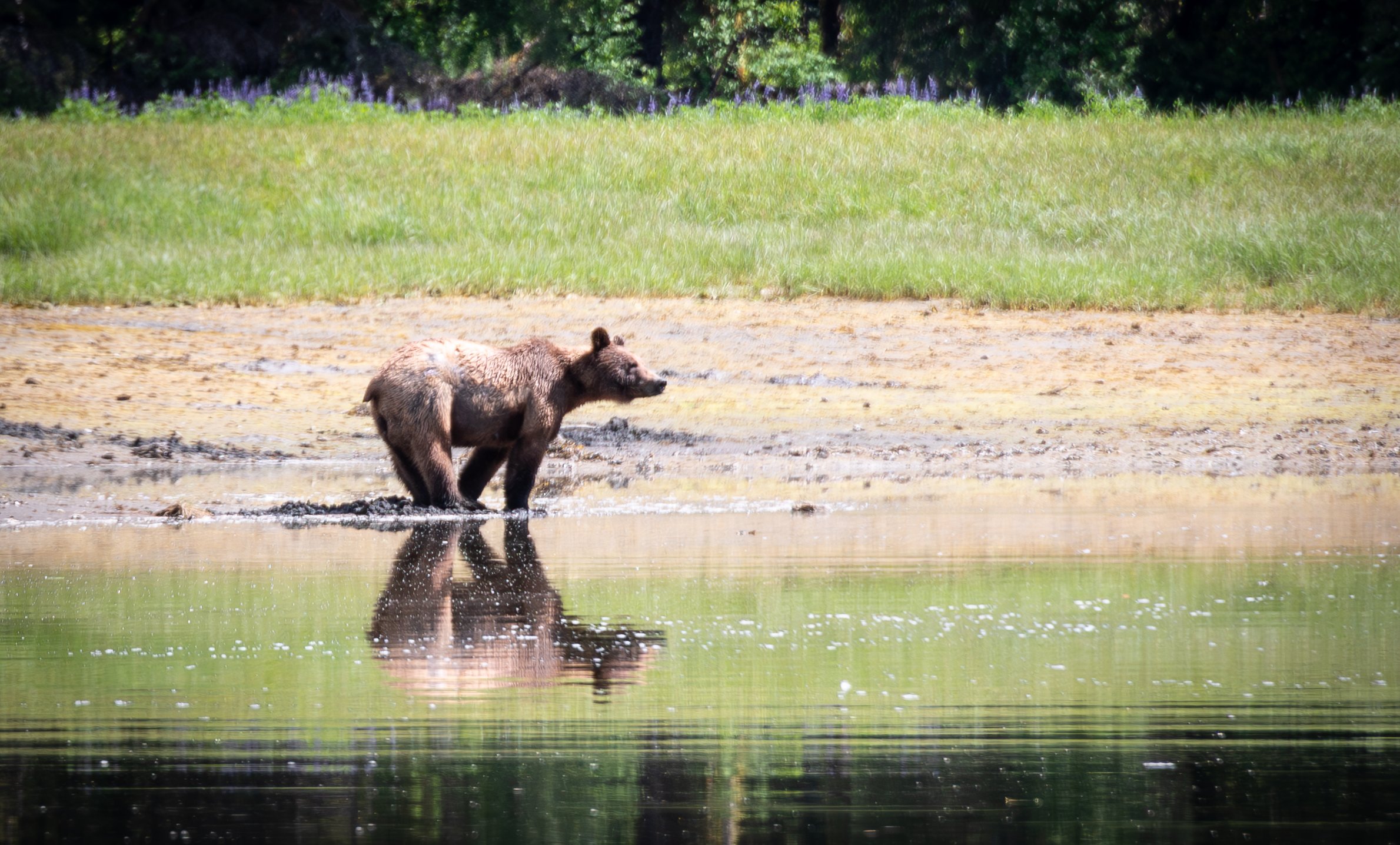Windy Bay to Khutze Inlet
/It’s an early wake-up call to time our arrival at Khutze Inlet at low water.
A low-water arrival lets us get a good look at the mud flats, which extend out further than you think and after often far different than what’s charted due to silting. We haven’t been here since 2011, so our memories are a bit fuzzy compared to Culpepper Lagoon. It’s just so much easier to anchor when you can see all the obstructions.
oceanflyer anchored at the head of khutze Inlet on a low tide
Like most Inlets with an alluvial fan, the bottom drops precipitously from the end of the fan. This makes it a challenge to drop in water that is not too deep - we try for a hundred feet - yet far enough from the edge of the mud flats so you can deploy enough rode without going aground. This is important, as inlets can get windy, especially in the afternoon.
My technique is to drive up to the edge of the flats, noting the depths as they rise. I have a minimum depth that I’m looking for – 10 feet under the boat at the lowest tide - and once I find that, I mark it on the chart. Then I measure out my estimated length of rode and motor out to that mark. If the depth at the anchor spot is acceptable, we release the anchor and set it well.
One advantage you do have is that you are backing uphill into the shallow water which gives your rode and anchor a great working angle. This comes with the disadvantage that if the winds blows you away from shore, you are now pulling away from the steep bottom, making easier to dislodge the anchor. That’s why we do not cheat on the amount of scope we use and set the anchor very well with at least three good tugs with power.
Khutze Inlet is about 5 miles long, with a beautiful estuary at the head. We were the only ones here when we arrived, which let us have our choice of anchor spots. It is really a stunning place, with a glorious waterfall, a beautiful valley surrounded by high peaks and a river. The Inlet, river estuary and uplands are part of the Khutze Conservancy, and it is nearly guaranteed that you’ll see bears this time of year. In fact, we saw brown bears in the distance from the moment we arrived.
previewing the waterways at low tide
As we settled in, we were soon joined by the S/V Passing Cloud, a charter ship we first saw in Shearwater. They anchored just off the waterfall and soon launched their dinghy to take passengers exploring.
entering the slough
We were already out in our dinghy, heading up the right hand side “slough” on a rising tide. That is where we saw the bears from the boat, so we thought we’d start there. The slough, mostly dry at low tide, becomes a navigable waterway through grassy areas at higher tides. We entered the slough with 14’ under the dinghy on a +12.6 foot rising tide.
Soon after we saw bears right at the water’s edge, and dropped the dinghy anchor so we could watch and photograph the bears without disturbing them. One was younger, and the other was larger and more mature. After a while, first one and then the other waded and then swam from one grassy section to another.
i wonder if these two are related, as you seldome see two bears so cloase
they move effortlessly though the marsh and waterways
lots of sitting and chewing. One in a while taking a pause to look around.
We continued down the slough, which was beautiful, and we went a fairly long way, just under a mile in total. We found a second waterfall and yet another bear. When we turned around, we were in 4.5 feet (and the tide was 15.2 feet, just before the high).
As we headed out of the slough to the other side of the anchorage (the river side), the Passing Cloud dinghy headed in. It was great timing, and we all got our own “private bear viewing”.
looking up the valley from the river entrance
The entry to the river is on the far far left of the anchorage as you look toward land. There is a large spit that sticks out, and you have to go around it to reach the entry channel. It was deeper than the slough, but just as pretty. We entered with 13.6 feet under us on a 15.3 foot tide.
the very shallow water and rapids was our stopping point
We went about 1.2 miles up the river before reaching the end of the navigable waterway and had to turn back. We saw one bear while exploring the river. Most of the shallow water was about 4 feet, the lowest we saw was about 3 feet on a +15.1 foot tide. It definitely is a benefit to visit when there are higher “high tides” to maximize the ability to explore by dinghy.
Between Khutze and Culpepper Lagoon, we had amazing brown bear viewing.
the signature waterfall at Khutze Inlet







































